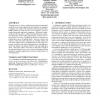Free Online Productivity Tools
i2Speak
i2Symbol
i2OCR
iTex2Img
iWeb2Print
iWeb2Shot
i2Type
iPdf2Split
iPdf2Merge
i2Bopomofo
i2Arabic
i2Style
i2Image
i2PDF
iLatex2Rtf
Sci2ools
MIDDLEWARE
2004
Springer
2004
Springer
Toward a standard ubiquitous computing framework
This paper surveys a variety of subsystems designed to be the building blocks from which sophisticated infrastructures for ubiquitous computing are assembled. Our experience shows that many of these building blocks fit neatly into one of five categories, each containing functionally-equivalent components. Effectively identifying the best-fit “lego pieces”, which in turn determines the composite functionality of the resulting infrastructure, is critical. The selection process, however, is impeded by the lack of convention for labeling these classes of building blocks. The lack of clarity with respect to what ready-made subsystems are available within each class often results in naive re-implementation of ready-made components, monolithic and clumsy implementations, and implementations that impose non-standard interfaces onto the applications above. This paper explores each class of subsystems in light of the experience gained over two years of active development of both ubiquito...
| Added | 02 Jul 2010 |
| Updated | 02 Jul 2010 |
| Type | Conference |
| Year | 2004 |
| Where | MIDDLEWARE |
| Authors | Martin Modahl, Bikash Agarwalla, Gregory D. Abowd, Umakishore Ramachandran, T. Scott Saponas |
Comments (0)

